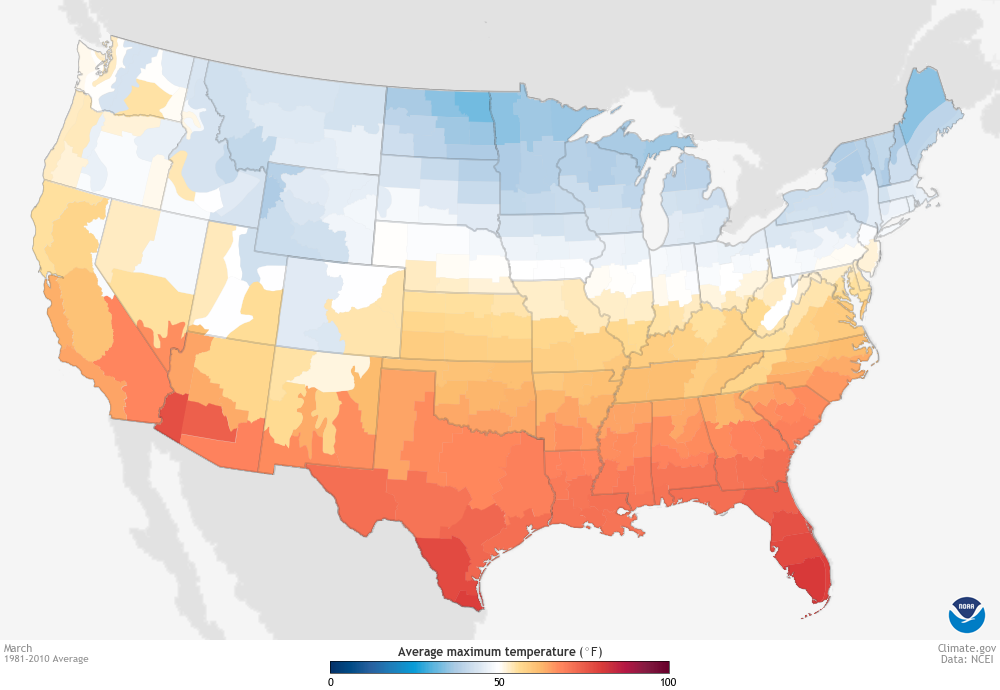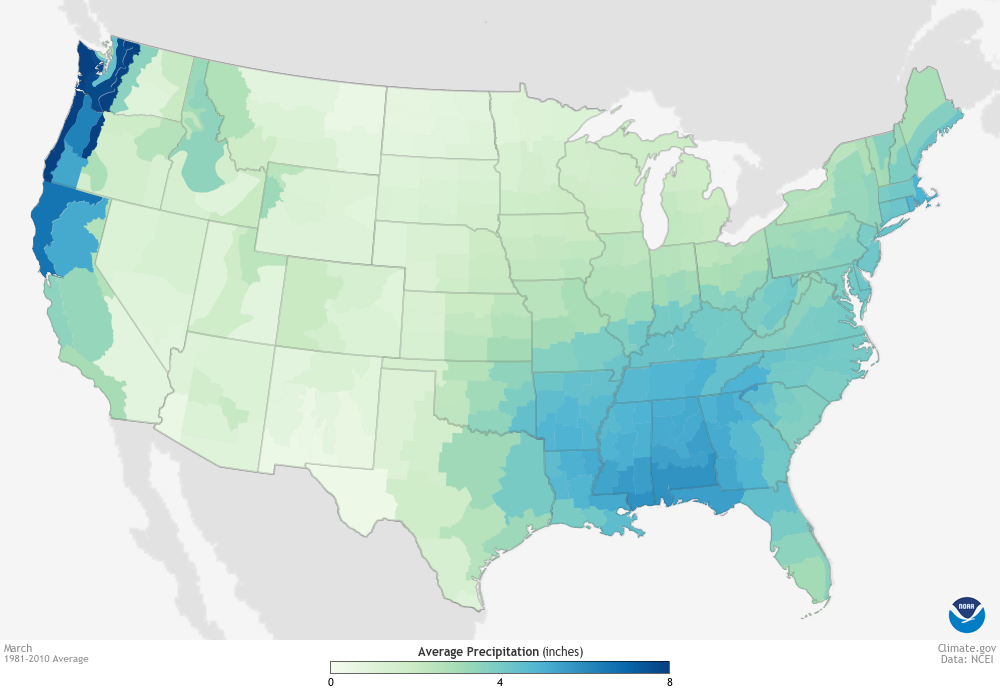NOAA’s Updated U.S. Climate Data Will Establish “New Normal”
Special Stories
2 Mar 2021 2:00 AM
[NCEI climatologist Anthony Arguez reviews El Niño/Southern Oscillation winter precipitation Climate Normals from NOAA for the contiguous United States. Courtesy of NOAA NCEI.]
[Written by NOAA] NOAA will soon release a much-anticipated update of U.S. climate data for placing recent weather conditions—such as heat waves and flooding rain—into historical context.
 [Normal high temperatures for March based off of the 1981-2010 averages. From NOAA]
Why is 30 years considered the standard? In 1935, the International Meteorological Organization—now known as the World Meteorological Organization—instructed member nations to calculate climate normals using a 30-year period, beginning with 1901–1930.
NOAA scientists produce traditional 30-year Normals that meet this international convention, but they have also provided other reference time periods as needed. For example, time series for climate change studies are often compared to a more-lengthy 1901–2000 average set, and supplemental normals for shorter periods are also provided.
[Normal high temperatures for March based off of the 1981-2010 averages. From NOAA]
Why is 30 years considered the standard? In 1935, the International Meteorological Organization—now known as the World Meteorological Organization—instructed member nations to calculate climate normals using a 30-year period, beginning with 1901–1930.
NOAA scientists produce traditional 30-year Normals that meet this international convention, but they have also provided other reference time periods as needed. For example, time series for climate change studies are often compared to a more-lengthy 1901–2000 average set, and supplemental normals for shorter periods are also provided.
 [Normal monthly precipitation for March based off of the 1981-2010 averages. From NOAA]
[Normal monthly precipitation for March based off of the 1981-2010 averages. From NOAA]
Climatologists from NOAA NCEI are currently compiling and reviewing 30 years of weather and climate data from across the U.S. to serve as the nation’s updated climate “normals” for the next 10 years. This new 30-year dataset will span from 1991 to 2020 and is scheduled for release in May 2021.
What Are Climate Normals?
Traditionally, scientists define climate normals as three-decade averages of climatological variables. The current batch of 30-year Climate Normals developed and used by NOAA covers the period from 1981 to 2010 and is calculated from observations at approximately 9,800 stations across the U.S. operated by NOAA National Weather Service. “NOAA’s Climate Normals provide a baseline to compare yesterday’s weather and tomorrow’s forecast to a standard for each location and time of year,” said Mike Palecki, project manager for NOAA’s 1991 to 2020 Climate Normals. “They can be used to understand the impacts of climate on many activities such as agriculture decision support, electricity load planning, building heating requirements calculation, construction scheduling, and many other factors impacting all sectors of the economy.” [Normal high temperatures for March based off of the 1981-2010 averages. From NOAA]
Why is 30 years considered the standard? In 1935, the International Meteorological Organization—now known as the World Meteorological Organization—instructed member nations to calculate climate normals using a 30-year period, beginning with 1901–1930.
NOAA scientists produce traditional 30-year Normals that meet this international convention, but they have also provided other reference time periods as needed. For example, time series for climate change studies are often compared to a more-lengthy 1901–2000 average set, and supplemental normals for shorter periods are also provided.
[Normal high temperatures for March based off of the 1981-2010 averages. From NOAA]
Why is 30 years considered the standard? In 1935, the International Meteorological Organization—now known as the World Meteorological Organization—instructed member nations to calculate climate normals using a 30-year period, beginning with 1901–1930.
NOAA scientists produce traditional 30-year Normals that meet this international convention, but they have also provided other reference time periods as needed. For example, time series for climate change studies are often compared to a more-lengthy 1901–2000 average set, and supplemental normals for shorter periods are also provided.
Calculating the New Climate Normals
Palecki emphasized that NOAA’s Normals are rather complicated sets of calculations, not just simple averages. These calculations fill in missing data using surrounding weather stations and ensure that daily Normals match monthly Normals. They also remedy discrepancies that might arise when stations change locations. In this next round of Climate Normals, new things will be added—including several small changes to how NCEI calculates them. “Our main methodologies have not changed since the last Normals cycle,” Palecki said. “But minor improvements have been made in how we round numbers, calculate percentiles, count the numbers of days exceeding thresholds, and format output.” [Normal monthly precipitation for March based off of the 1981-2010 averages. From NOAA]
[Normal monthly precipitation for March based off of the 1981-2010 averages. From NOAA]
Also, for the first time, this updated batch of Normals will include 15-year Normals for those needing a climatology representing a period closer to today. NOAA will also release high spatial resolution monthly Normals data for the conterminous U.S., as well as develop new tools and methods to access the data.
“These new Normals are a better baseline for today’s climate, helping inform activities in many economic sectors,” Palecki added. “Interestingly, this shift will result in there being fewer ‘above normal’ temperature days in most of the U.S. at the start of this decade compared to recent years that used the previous Normals cycle. Climate will continue to change in the U.S. during this decade, however, so we will need to do this again in 2031.” Once the new NOAA Normals are released in May 2021, they will be available to the public from NCEI.All Weather News
More